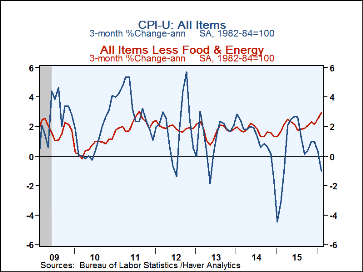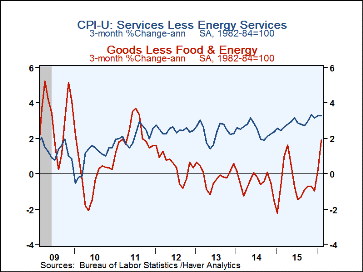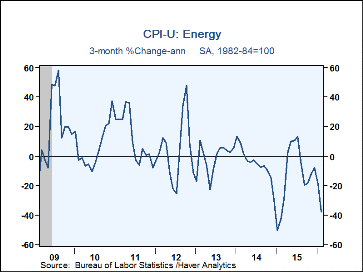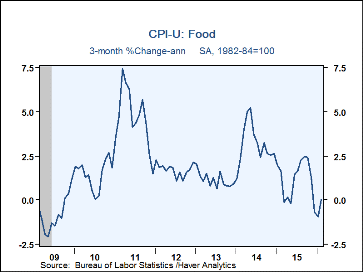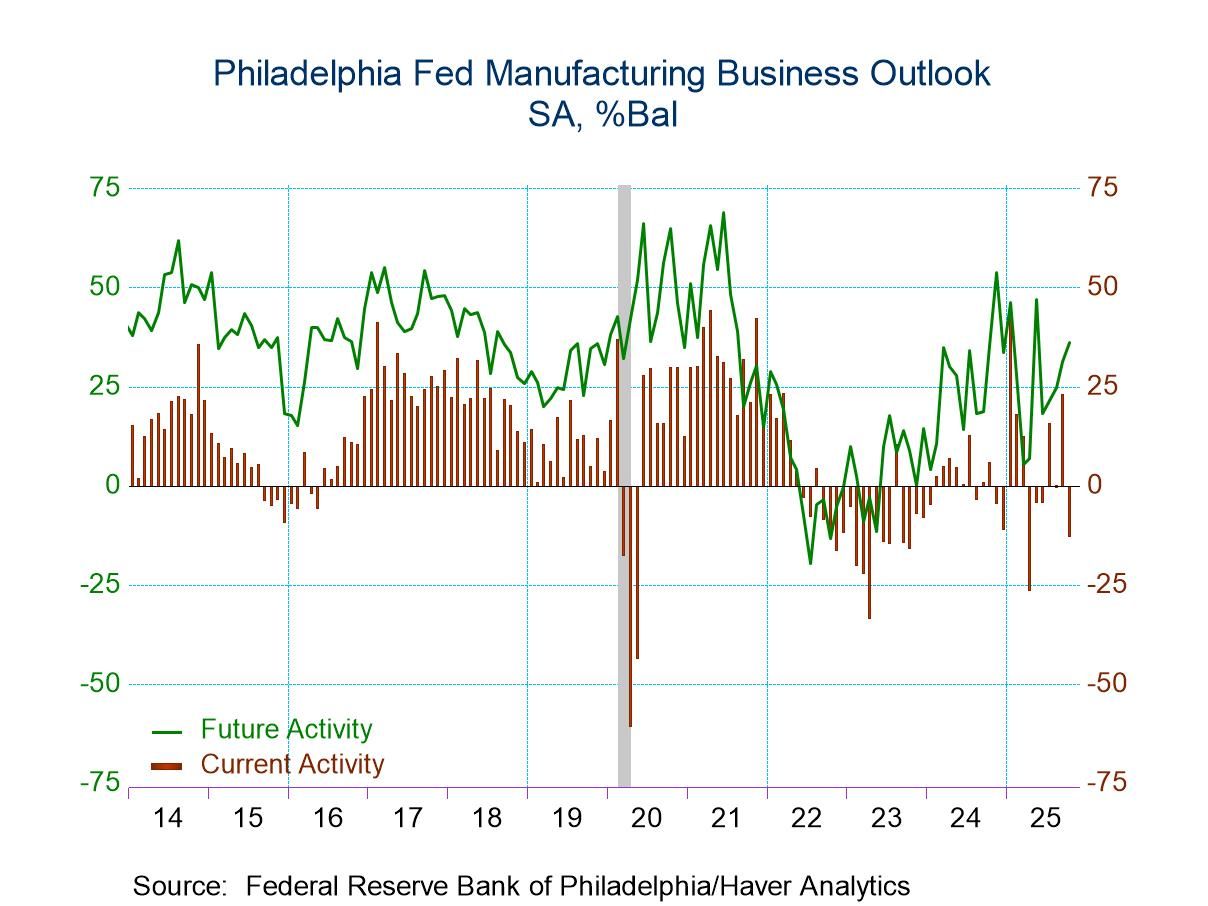 Global| Mar 16 2016
Global| Mar 16 2016U.S. CPI Declines With Energy Prices; Core Remains Firm
by:Tom Moeller
|in:Economy in Brief
Summary
The Consumer Price Index fell an expected 0.2% during February (+1.0% y/y) following no change in January. A 6.0% decline (-12.5% y/y) in energy prices accounted for the bulk of the downward pressure. Excluding both food & energy, [...]
The Consumer Price Index fell an expected 0.2% during February (+1.0% y/y) following no change in January. A 6.0% decline (-12.5% y/y) in energy prices accounted for the bulk of the downward pressure. Excluding both food & energy, prices increased 0.3% (2.3% y/y), the same as in January. A 0.2% rise had been expected in the Action Economic Forecast Survey.
Energy prices have fallen in each month since July, last month lead by a 13.0% drop (-20.7% y/y) in gasoline prices. Fuel oil prices also were off 2.9% (-32.1% y/y) while electricity costs eased 0.2% (-3.0% y/y). Natural gas prices gained 1.0% (-10.3% y/y), up for the first month in the last six.
Services prices other than energy continued to provide strength to the total CPI. The 0.3% increase was the fifth such rise in the last six months. It raised the y/y change to 3.1%, the strongest rise since 2008. A 0.5% increase (3.9% y/y) was logged by medical care services prices, the same as in January. Recreation services prices also rose 0.5% (2.7% y/y), the strongest increase since January last year. Shelter prices rose 0.3% (3.3% y/y), the same in the prior month, reflecting a 0.3% gain (3.2% y/y) in owners' equivalent rent of primary residences. Rental costs also increased a steady 0.3% (3.7% y/y). Transportation services prices improved 0.2% (2.6% y/y), though that was easier than the prior month's 0.4% rise. It occurred as public transportation prices gained just 0.1% (-0.1% y/y) following a 0.7% spurt. Education & communication services prices eased 0.1% (+1.8% y/y), but tuition costs jumped 0.4% (3.4% y/y) following stability in the prior month.
Prices for goods other than food & energy increased 0.3% (0.1% y/y), the strongest monthly performance since August 2011. Apparel prices surged 1.6% (0.9% y/y) after a 0.6% rise. Medical care commodity prices improved 0.6% (2.2% y/y), the strongest gain since December 2014. New vehicle prices rose 0.2% (0.6% y/y), only the second increase in twelve months. Alcoholic beverage costs strengthened 0.2% after a 0.5% rise, lifting the y/y increase to 1.3%, its firmest in a year. To the downside were recreation product prices by 0.5% (-2.6% y/y), the fifth decline in as many months. The prices of educational books & supplies remained unchanged (+3.2% y/y) while appliance costs fell 0.3% (-2.9% y/y), reversing the prior month's increase. Home furnishings & supplies costs declined 0.2% (-1.0% y/y) after a 0.1% downtick.
Food & beverage prices increased 0.2% (0.9% y/y) following four straight months of little change. A 1.0% rise (5.0% y/y) in fresh fruit & vegetable prices led the gain as it built on a 1.6% increase in the prior month. A 0.4% rise (6.0% y/y) in egg prices followed four months of sharp decline. Cereal & bakery prices gained 0.2% (0.6% y/y) and reversed the January decline. Nonalcoholic beverage prices jumped 0.6% (0.2% y/y) after a 0.2% decline, but meat, poultry & fish prices eased 0.1% (-3.7% y/y), down for the sixth straight month.
The consumer price data is available in Haver's USECON database while detailed figures can be found in CPIDATA. The expectations figure is from Action Economics and is found in the AS1REPNA database.
Worst-Case Scenarios and Asset Prices from the Federal Reserve Bank of Francisco can be found here.
| Consumer Price Index, All Urban Consumers (%) | Feb | Jan | Dec | Feb Y/Y | 2015 | 2014 | 2013 |
|---|---|---|---|---|---|---|---|
| Total | -0.2 | 0.0 | -0.1 | 1.0 | 0.1 | 1.6 | 1.5 |
| Total less Food & Energy | 0.3 | 0.3 | 0.2 | 2.3 | 1.8 | 1.7 | 1.8 |
| Goods less Food & Energy | 0.3 | 0.2 | -0.1 | 0.1 | -0.5 | -0.3 | -0.0 |
| Services less Energy | 0.3 | 0.3 | 0.2 | 3.1 | 2.6 | 2.5 | 2.4 |
| Food | 0.2 | 0.0 | -0.2 | 0.9 | 1.9 | 2.4 | 1.4 |
| Energy | -6.0 | -2.8 | -2.8 | -12.5 | -16.7 | -0.3 | -0.7 |
Tom Moeller
AuthorMore in Author Profile »Prior to joining Haver Analytics in 2000, Mr. Moeller worked as the Economist at Chancellor Capital Management from 1985 to 1999. There, he developed comprehensive economic forecasts and interpreted economic data for equity and fixed income portfolio managers. Also at Chancellor, Mr. Moeller worked as an equity analyst and was responsible for researching and rating companies in the economically sensitive automobile and housing industries for investment in Chancellor’s equity portfolio. Prior to joining Chancellor, Mr. Moeller was an Economist at Citibank from 1979 to 1984. He also analyzed pricing behavior in the metals industry for the Council on Wage and Price Stability in Washington, D.C. In 1999, Mr. Moeller received the award for most accurate forecast from the Forecasters' Club of New York. From 1990 to 1992 he was President of the New York Association for Business Economists. Mr. Moeller earned an M.B.A. in Finance from Fordham University, where he graduated in 1987. He holds a Bachelor of Arts in Economics from George Washington University.


